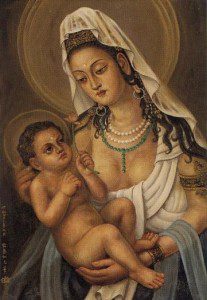For many of my liturgically minded Christian friends, particularly Catholics of those various stripes I know and often love and a goodly number of Anglicans (ditto), today is marked as the Nativity of Mary. Mary, as many who visit this blog know, I call my favorite goddess. She is the most widely known of the Western incarnations of as the archetype of love, of compassion. And that love, that compassion is something this world so desperately needs.
While she indeed has many faces, for me the other is Guanyin, here in the West the call of love and compassion most commonly turns on Mary.
So, a feast for Mary.
A small factoid in regard to this holiday is that while saints are normally noted liturgically on the date of their death, the time they enter their heavenly glory, Mary doesn’t have a death date, as the tradition has her assumed bodily into Heaven – as seems appropriate for the mother of God. Although it should be noted that Hyppolitus of Thebes who writing in the seventh or eighth centuries stated as if were fact that she lived for eleven years after the death of her son and dying in the year 41.
That said, and there is also that less pleasant idea that she was, like her boy, immaculately conceived and therefore lacking the taint of sin from being conceived, you know, the regular way. And therefore it was okay to celebrate her birth. This appears to start with the apocryphal Gospel According to James, alleged to be written by Jesus’ brother (well, sort of, as this is the source of the claim the brothers were all Joseph’s from an earlier marriage). She this text asserts was never “soiled” by carnal intercourse. It’s also here we get Mary’s parents names, Anne & Joachim. Most scholars date the text late in the second century, although there is no independent citation of it earlier than the third century.
All that stirs together as the myth of Mary. Some of it good, much of it. Some of it not. But, like all divine presentations, a mixed bag.
And here I do mean myth in pretty much the best sense of the word. As I noted at the beginning of this little reflection, she is my favorite goddess – even with all the other stuff attached to her, our projections of our prejudices as well as our projections of hope, she becomes at last as an incarnation of love, of compassion.
And it is here out of the mess that most powerful of human experience, love, compassion arising, that the divine and the earth touch, and it touches us as a mother’s hand.
For me the deal is that we have these possibilities within our own hearts. And then as we project these into the cosmos we can see them a bit more clearly. Then the thing is to take advantage of the invitation, and return that attention, that care, that love, that compassion to this poor hurting planet.
And, as I said, that is something we desperately need.













